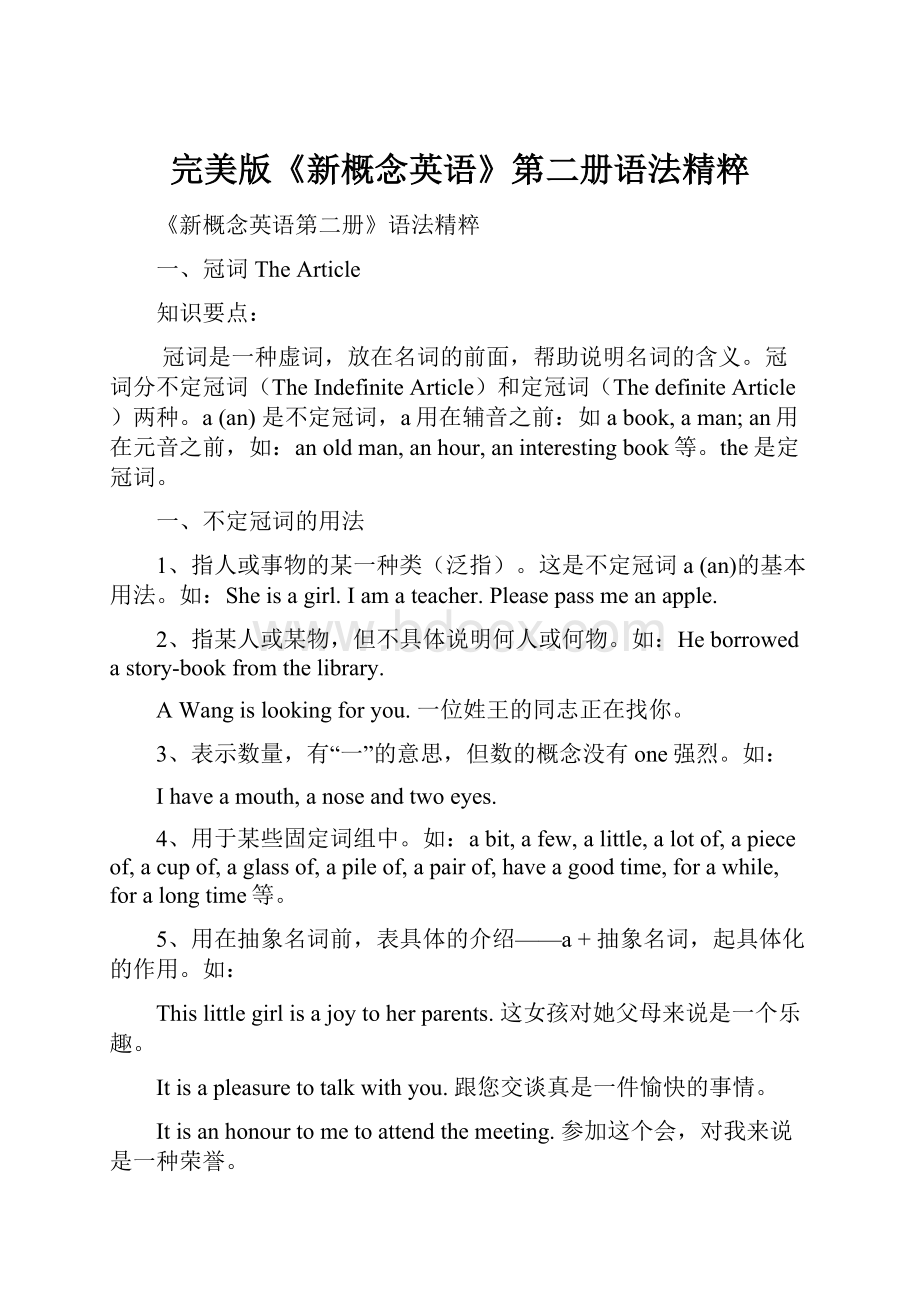完美版《新概念英语》第二册语法精粹.docx
《完美版《新概念英语》第二册语法精粹.docx》由会员分享,可在线阅读,更多相关《完美版《新概念英语》第二册语法精粹.docx(196页珍藏版)》请在冰豆网上搜索。

完美版《新概念英语》第二册语法精粹
《新概念英语第二册》语法精粹
一、冠词TheArticle
知识要点:
冠词是一种虚词,放在名词的前面,帮助说明名词的含义。
冠词分不定冠词(TheIndefiniteArticle)和定冠词(ThedefiniteArticle)两种。
a(an)是不定冠词,a用在辅音之前:
如abook,aman;an用在元音之前,如:
anoldman,anhour,aninterestingbook等。
the是定冠词。
一、不定冠词的用法
1、指人或事物的某一种类(泛指)。
这是不定冠词a(an)的基本用法。
如:
Sheisagirl.Iamateacher.Pleasepassmeanapple.
2、指某人或某物,但不具体说明何人或何物。
如:
Heborrowedastory-bookfromthelibrary.
AWangislookingforyou.一位姓王的同志正在找你。
3、表示数量,有“一”的意思,但数的概念没有one强烈。
如:
Ihaveamouth,anoseandtwoeyes.
4、用于某些固定词组中。
如:
abit,afew,alittle,alotof,apieceof,acupof,aglassof,apileof,apairof,haveagoodtime,forawhile,foralongtime等。
5、用在抽象名词前,表具体的介绍——a+抽象名词,起具体化的作用。
如:
Thislittlegirlisajoytoherparents.这女孩对她父母来说是一个乐趣。
Itisapleasuretotalkwithyou.跟您交谈真是一件愉快的事情。
Itisanhonourtometoattendthemeeting.参加这个会,对我来说是一种荣誉。
二、定冠词的用法:
1、特指某(些)人或某(些)事物。
这是定冠词the的基本用法。
如:
BeijingisthecapitalofChina.
Thepenonthedeskismine.
2、指谈话双方都知道的人或事物。
如:
Whereistheteacher?
Openthewindow,please.
3、指上文提过的人或事物(第二次出现)。
如:
Therewasachairbythewindow.Onthechairsatayoungwomanwithababyinherarms.
Thebabywasthin.
4、用在世界上独一无二的事物前。
如:
theearth,themoon,thesun.
5、用在序数词和形容词最高级前。
(副词最高级前的定冠词可省略)如:
Heisalwaysthefirsttocometoschool.
Bobisthetallestinhisclass.
6、用在某些专有名词前(由普通名词构成的专用名词)。
如:
theGreatWall,theSummerPalace,theScienceMuseum,theChildren’sPalace,theParty等。
7、用在一些习惯用语中。
如:
ontheday,inthemorning(afternoon,evening),thedayaftertomorrow,thedaybeforeyesterday,thenextyear,bytheway等。
8、用在江河湖海、山脉前。
如:
theYellowRiver,thePacificOcean,theAlps,theHimalayas
9、用在报刊、杂志前。
如:
thePeople’sDaily,theEveningPaper,theTimes泰晤士报。
10、表示某一家人要加定冠词。
如:
TheBrownsareathometoreceivevisitorstoday.布朗一家今天要接待客人。
11、用在形容词前,表某一类人。
如:
thepoor,thewounded,theliving,thedead,therich,thesick等。
12、定冠词可以表示一事物内部的某处。
如:
Thedriveralwayssitsinthefrontofthebus(car).
三、零冠词(即不用冠词):
1、专用名词和不可数名词前。
如:
China,America,GradeOne,ClassTwo,milk,oil,water,paper,science等。
2、名词前已有作定语用的this,that,my,your,some,any等代词。
如:
Godownthisstreet.
3、复数名词表示一类人或事物时。
如:
Wearestudents.Ilikereadingstories.
4、节日、日期、月份、季节前。
如:
Teachers’Day,Children’sDay,NationalDay,insummer,inJuly等。
TodayisNewYear’sDay.ItisSunday.March8isWomen’sDay.
5、在称呼语或表示头衔的名词前,尤其作表语、宾补时。
如:
What’sthematter,Granny?
Weelectedhimmonitor.
6、在某些习惯用语中的名词前。
如:
atnoon,atnight,atfirst,atlast,atmost,atleast,bybus(train,air,sea),inbed,intime,infrontof,gotoschool,gotobed,gotocollege,onfoot,attable,inink,inpencil等。
7、在三餐饭和球类运动前。
如:
Shegoestoschoolafterbreakfasteverymorning.
Wearegoingtoplayfootball.
Weusuallyhavelunchatschool.
8、科目前不加。
如:
WelearnChinese,maths,Englishandsomeothersubjects.
【专项训练】:
1、Wecan’tlivewithoutair.
A.anB.×C.theD.some
2、——Haveyouseenpen?
Ileftitherethismorning.
——Isitblackone?
IthinkIsawitsomewhere.
A.a;theB.the;theC.the;aD.a;a
3、I’vebeenwaitingforhimforhourandhalf.
A.×;×B.the;aC.a;theD.an;a
4、Whatfineweatherwehavetoday!
A.aB.×C.someD.an
5、Haveyoueverseenastallasthisone?
A.atreeB.suchtreeC.antreeD.tree
6、Childrenusuallygotoschoolatageofsix.
A.×;theB.a;anC.the;×D.the;the
7、Himalayasishighestmountaininworld.
A.×;the;×B.The;the;theC.A;a;aD.×;×;×
8、Theyeachhave__book.LiHua’sisaboutwriter.WangLin’sisonscience.
A.a;a;×B.the;×;theC.×;the;×D.a;the;a
9、Physicsisscienceofmatterandenergy.
A.The;×B.×;×C.×;theD.A;a
10、sunrisesineastandsetsinwest.
A.A;an;aB.The;×;×C.The;the;theD.A;the;a
11、Manypeopleagreethat__knowledgeofEnglishisamustininternationaltradetoday.
A.a;×B.the;anC.the;theD.×;the
12、__MrJonescalledwhileyouwereout(neitherofusknowsthisman).Hewasinbad
temper.A.×;aB.A;×C.The;theD.A;a
13、Theywereatdinnerthen.Itwasdelicousone.
A.a;theB.×;×C.×;aD.a;a
14、whatkindofcardoyouwanttobuy?
A.×B.theC.aD.an
15、AliceisfondofplayingpianowhileHenryisinterestedinlisteningtomusic.
A.×;theB.×;×C.the;×D.the;the
16、Beyondstars,theastronautsawnothingbutspace.
A.the;×B.×;theC.×;×D.the;the
17、AlexanderGrahamBellinventedtelephonein1876.
A.×B.aC.theD.one
18、——Where’sJack?
——Ithinkhe’sstillinbed,buthemightjustbeinbathroom.
A.×;×B.the;theC.the;×D.×;the
19、Manypeoplearestillinhabitofwritingsillythingsinpublicplaces.
A.the;theB.×;×C.the;×D.×;the
20、——I’dlikeinformationaboutthemanagementofyourhotel,please.
——Well,youcouldhavewordwiththemanager.Hemightbehelpful.
A.some;aB.an;someC.some;someD.an;a
【答案】:
1、Bair是不可数名词。
2、D此题为97年高考题。
根据句意,第一空是泛指,第一次出现;第二空仍是泛指,且表数量“-”。
3、D元音前用an。
4、Bweather是不可数名词。
5、A此题为85年高考题。
泛指。
6、Agotoschool是固定短语。
7、B山脉、形容词最高级及世界上的唯一的名词前加定冠词。
8、A第一、二空泛指,第三空,science是不可数名词。
9、C第一空,科目前不加冠词;第二空特指,有定语。
10、C
11、A第一空,a+不可数名词表具体的介绍;第二空,trade不可数。
12、D第一空是指有一位琼斯先生在您不在的时候来访。
(括号里说明,我们俩都不认识这个人,因此不是特指。
)第二空是固定短语,情绪不好。
13、C第一空atdinner正在吃饭,固定短语。
14、A泛指
15、C此题是89年高考题:
乐器前加定冠词;music是不可数名词。
16、A此题是90年高考题:
stars前应加定冠词;space不可数。
17、C此题是91年高考题:
发明应是特指。
18、D此题是92年高考题。
inbed是固定短语,不加冠词。
19、C此题是93年高考题。
第一空后有定语,固是特指。
第二空,publicplaces,公共场所,泛指。
20、A此题是95年高考题。
information是不可数名词;haveawordwithsb.是固定短语。
二、名词Nouns
知识要点:
一、名词的种类:
1、专有名词:
1)China,Japan,Beijing,London,Tom,Jack(不加冠词)
2)theGreatWall,theYellowRiver,thePeople’sRepublicofChina,theUnitedStates等。
(由普通名词构成的专有名词,要加定冠词。
)
2、普通名词
1)不可数名词
注意:
不可数名词前一般不加冠词,尤不加不定冠词:
若加a(an)则使之具体化了。
如:
haveawonderfultime.
不可数名词作主语,谓语动词用第三人称单数形式。
不可数名词一般无复数形式。
部分物质名词在表不同类别时,可用复数形式。
如:
fishes,newspapers,waters,snows……
|||
各种各样的鱼各种报纸河湖、海水积雪
有些抽象名词也常用复数,变为可数的具体的事物。
如:
times时代,works著作,difficulties困难
在表数量时,常用“of”词组来表示。
如:
aglassofmilk,acupoftea,twopiecesofpaper….
2)可数名词:
可数名词除用复数形式表一类之外,一般都要加冠词:
Abirdcanfly.
Thefrogisakindofhibernatinganimal.
Vegetablessoldatthisshopareusuallyfresh.
有复数形式:
a)规则变化——加“s”或“es”(与初中同,略)
b)不规则变化——child(children),foot(feet),tooth(teeth),man(men),
woman(women),mouse(mice),goose(geese),Englishman(Englishmen),
phenomenon(phenomena)…
注意:
c)单、复数同形:
sheep,deer,Chinese,Japanese,fish(同一种鱼)……。
如,asheep,twosheep
d)只用复数形式:
thanks,trousers,goods,clothes,socks,shoes,…
e)形复实单:
physics,politics,maths,news,plastics(塑料),means.
f)形单实复:
people(人民,人们),thepolice,cattle等
g)集合名词如:
family,public,group,class等。
当作为整体时,为单数;当作为整体中的各个成员时,为复数。
如:
Myfamilyisabigone.Myfamilyaremusiclovers.
h)复合名词变复数时,(a)只把复合名词中的主体各词变为复数形式。
如:
sister(s)-in-law嫂子,弟妹;step-son(s)继子;editor(s)-in-chief总编辑。
(b)如没有主体名词则在最后一个词的后面加“s”。
如:
grown-up(s)成年人,go-between(s)中间人
(c)woman,man作定语时,要与被修饰的名词的数一致。
如:
amanservant—menservants,awomandoctor—womendoctors
二、名词的所有格:
1、表有生命的东西(人或动物)的名词所有格,一般在名词后加“’s”。
如:
Mike’sbag,Children’sDay,mybrother’sroom,women’srights…
注意:
1)名词复数的词尾是-s或-es,它的所有格只在词后加“s”。
如:
Teachers’Day,theworkers’rest-home(工人疗养院),thestudents’reading-room
2)复合名词的所有格,在后面的词后加“’s”。
如:
herson-in-law’sphoto(她女婿的照片);anybodyelse’sbook(其他任何人的书)
3)如果一样东西为两人或两人以上共有,则在最后的一个名词后面加“’s”;如果不是共有,则每个词后都要加“’s”。
如:
JaneandHelen’sroom.珍妮和海伦的房间(共有).Bill’sandTom’sradios.比尔的收音机和汤姆的收音机(不共有)
4)表地点(店铺,某人的家等)的名词所有格后面,一般省去它所修饰的名词。
如:
thetailor’s(裁缝铺)thedoctor’s(诊所)Mr.Brown’s(布朗先生的家)
5)有些表时间、距离、国家、城镇的无生命的名词,也可加“’s”表所有格。
如:
halfanhour’swalk(半小时的路程)China’sagriculture(中国的农业)
2、表示无生命的东西的名词一般与of构成词组,表示所有格。
如:
thecoverofthebook
3、表示有生命的东西的名词也可以用of,特别是名词较长,有较多的定语时。
如:
thestoryofDrNormanBethune
Doyouknowthenameoftheboystandingatthegate?
4、“of词组+所有格”的用法:
在表示所属物的名词前有冠词、数词、不定代词或指示代词(如:
a,two,some,afew,this,that,these,those等)时,常用“of词组+所有格”的形式来表示所有关系。
如:
afriendofmyfather’s我父亲的一位朋友。
someinventionsofEdison’s爱迪生的一些发明
thoseexercise-booksofthestudents’学生们的那些练习本。
【专项训练】:
1、Thereareonlytwelveinthehospital.
A.womandoctorsB.womendoctors
C.womendoctorD.womandoctor
2、MrSmithhastwo,bothofwhomareteachersinaschool.
A.brothers-in-lawB.brother-in-laws
C.brothers-in-lawsD.brothers-inlaw
3、——Howmanydoesacowhave?
——Four.
A.stomachesB.stomachC.stomachsD.stomachies
4、SomevisitedourschoollastWednesday.
A.GermanB.GermenC.GermansD.Germens
5、Theofthebuildingarecoveredwithlotsof.
A.roofs;leavesB.rooves;leafsC.roof;leafD.roofs;leafs
6、Whenthefarmerreturnedhomehefoundthreemissing.
A.sheepsB.sheepesC.sheepD.sheepies
7、Thatwasafiftyengine.
A.horsepowerB.horsespower
C.horsepowersD.horsespowers
8、Myfatheroftengivesme.
A.manyadviceB.muchadviceC.alotofadvicesD.afewadvice
9、Marybrokeawhileshewaswashingup.
A.teacupB.acupofteaC.tea’scupD.cuptea
10、Canyougiveussomeaboutthewriter?
A.informationsB.information
C.pieceofinformationsD.piecesinformation
11、Ihadacupofandtwopiecesofthismorning.
A.teas;breadB.teas;breads
C.tea;breadsD.tea;bread
12、Asisknowntousall,travelsmuchfasterthan.
A.lights;soundsB.light;sound
C.sound;lightD.sounds;lights
13、Shetoldhimofallherand.
A.hope;fearB.hopes;fear
C.hopes;fearsD.hope;fears
14、Therisingdidalotoftothecrops.
A.water;harmB.water;harms
C.waters;harmD.waters;harms
15、——Howfarawayisitfromheretoyourschool?
——It’sabout.
A.halfanhour’sdriveB.halfhoursdrives
C.halfanhourdrivesD.half